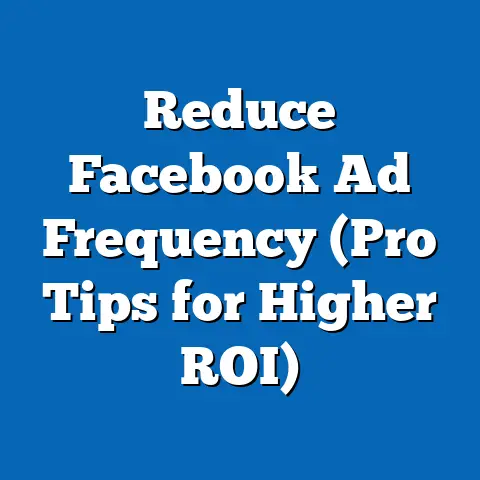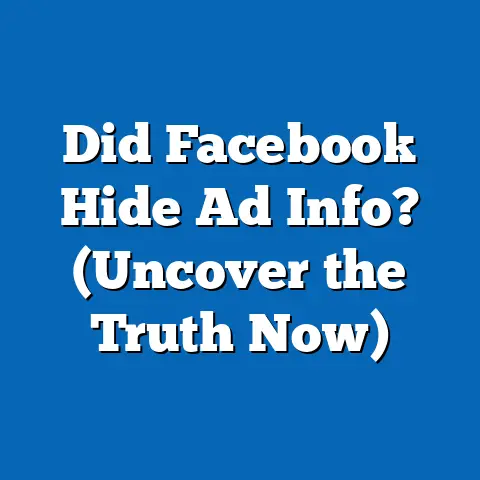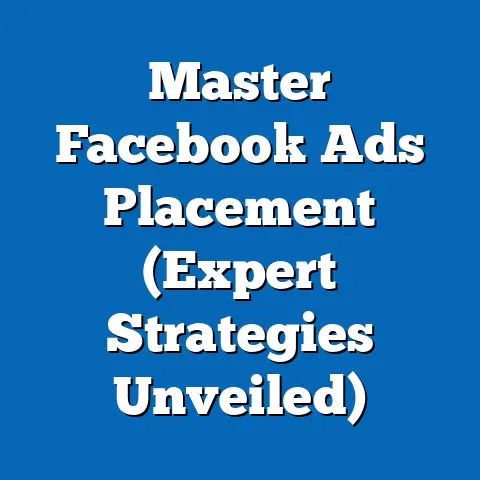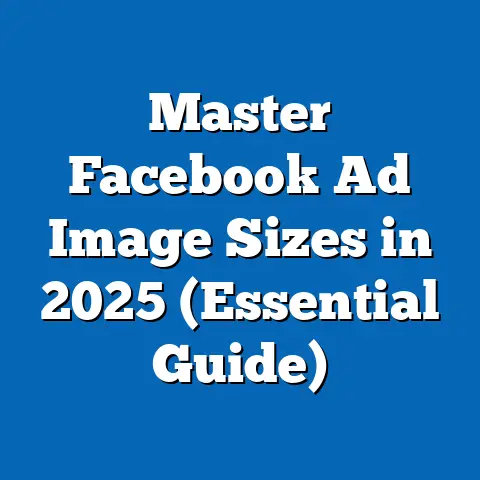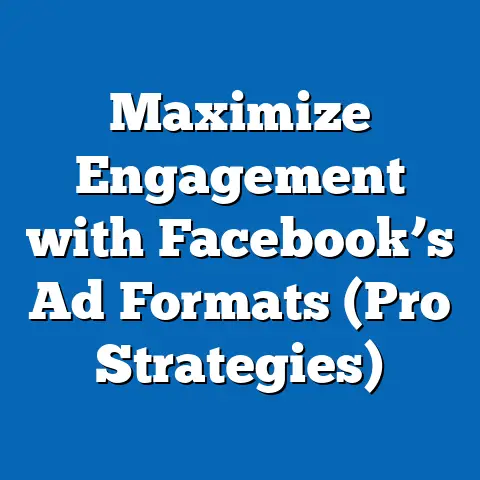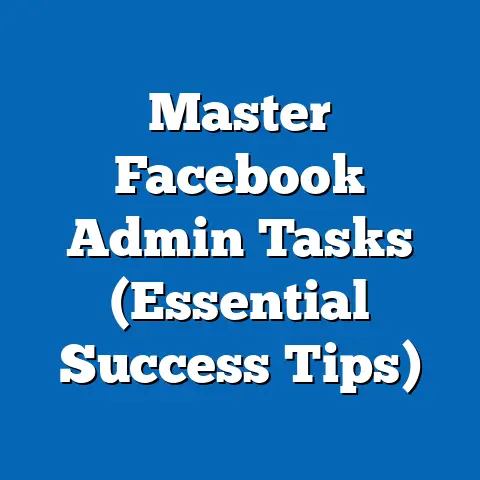Why Facebook Feels Overrun by Ads (Ad Saturation Insights)
Have you ever scrolled through your Facebook feed and felt like you were wading through a sea of sponsored posts? You’re not alone. I’ve been working in digital marketing for over a decade, and I’ve witnessed firsthand the evolution of Facebook from a social networking platform to a powerful advertising engine. Today, it often feels like the balance has tipped, with ads dominating our feeds more than ever before.
In 2023, Facebook’s advertising revenue reached a staggering $134.9 billion, a clear indicator of how central advertising is to their business model. But this massive influx of ads has led to what many are calling “ad saturation,” a point where the sheer volume of ads overwhelms users and diminishes the effectiveness of individual campaigns.
Industry experts are increasingly vocal about this phenomenon. As digital marketing expert Neil Patel has stated, “Consumers are getting smarter and more resistant to traditional advertising methods. It’s crucial to focus on delivering value and building trust.” This sentiment is echoed by many others in the field, who believe that the current level of ad saturation is unsustainable and requires a significant shift in strategy.
Understanding Ad Saturation
Ad saturation, in the context of digital marketing, refers to the point where the volume of advertising on a platform becomes so high that it diminishes the effectiveness of individual ads and negatively impacts the user experience. It’s not just about the number of ads; it’s about the ratio of ads to organic content, the relevance of those ads, and how frequently users are exposed to them.
Measuring Ad Saturation
Measuring ad saturation is a complex task, involving a combination of quantitative and qualitative data. Some key metrics I look at include:
- Frequency: This measures how many times a user sees a particular ad within a given timeframe. A high frequency can quickly lead to ad fatigue.
- Impressions vs. Clicks: A low click-through rate (CTR) despite a high number of impressions can indicate that users are seeing the ads but are no longer engaging with them.
- Cost Per Click (CPC): In a saturated market, advertisers often have to bid higher to get their ads seen, driving up CPC.
- User Feedback: Surveys and social media sentiment analysis can provide valuable insights into how users are feeling about the number and quality of ads they’re seeing.
While there’s no universally agreed-upon “saturation threshold,” I’ve found that when frequency starts consistently exceeding 3-4 per week for the same user, and CTR drops significantly, it’s a strong indicator that ad saturation is becoming a problem.
Psychological Effects of Ad Saturation
The psychological effects of ad saturation are significant. Overexposure to ads can lead to:
- Ad Fatigue: Users become tired of seeing the same ads repeatedly, leading to decreased attention and engagement.
- Ad Blindness: Users subconsciously ignore ads, even if they are relevant. This is a learned behavior, where the brain filters out anything it perceives as an advertisement.
- Negative Brand Perception: If users feel bombarded by ads, they may develop a negative association with the brand, even if the product or service is good.
- Decreased Trust: A constant stream of ads can erode trust in the platform and the advertisers, as users feel they are being constantly sold to.
These psychological effects are well-documented in academic research. For example, a study published in the Journal of Advertising Research found that repeated exposure to irrelevant ads can lead to irritation and a decrease in brand recall.
Industries Contributing to Saturation
Certain industries heavily utilize Facebook ads, contributing significantly to the overall saturation. These often include:
- E-commerce: Online retailers are constantly vying for attention, leading to a high volume of product ads.
- Subscription Services: Companies offering streaming, software, or other subscription-based products rely heavily on Facebook ads for customer acquisition.
- Gaming: Mobile game developers spend vast sums on Facebook ads to attract new players.
- Finance: Financial institutions and investment platforms also contribute to ad saturation.
In my experience, these industries often employ aggressive retargeting strategies, which, while effective, can exacerbate ad fatigue if not carefully managed.
Key Takeaway: Ad saturation is a complex issue with measurable indicators and significant psychological effects. Understanding these factors is crucial for both users and advertisers looking to navigate the Facebook landscape effectively.
The Evolution of Facebook Advertising
To truly understand the current state of ad saturation, it’s important to trace the evolution of Facebook advertising. The platform has undergone a dramatic transformation since its early days, and its advertising model has evolved in tandem.
From Organic Reach to Paid Advertising
In the early days of Facebook, businesses could build a significant following and reach a large portion of their audience organically, without spending a dime on advertising. However, as Facebook’s user base grew, and the platform’s algorithm became more sophisticated, organic reach began to decline.
This shift was driven by several factors:
- Algorithm Changes: Facebook’s algorithm, designed to prioritize content from friends and family, gradually de-emphasized posts from business pages.
- Increased Content Volume: As more businesses joined Facebook, the competition for attention in the newsfeed increased, making it harder for organic posts to stand out.
- Monetization Strategy: Facebook needed to generate revenue, and advertising became the primary means of doing so.
This shift from organic reach to paid advertising was a gradual but significant change. I remember when businesses started complaining that their posts were no longer reaching their entire audience, even with a large following. This was the beginning of the “pay-to-play” era on Facebook.
Key Changes in Algorithms and User Engagement
Facebook’s algorithm has undergone numerous changes over the years, each impacting how users engage with content and how advertisers reach their target audience. Some key algorithm updates include:
- EdgeRank: Facebook’s initial algorithm, which prioritized content based on affinity, weight, and time decay.
- News Feed Optimization: Updates focused on showing users the content they were most likely to engage with, based on their past behavior.
- Fighting Clickbait: Efforts to reduce the spread of sensational or misleading content.
- Prioritizing Meaningful Interactions: Updates designed to promote conversations and connections between users.
These algorithm changes have had a profound impact on advertising. For example, the focus on “meaningful interactions” has made it more challenging for businesses to reach users with purely promotional content. Advertisers now need to create engaging, valuable content that encourages interaction to succeed.
Facebook’s Business Model and Advertising Revenue
Facebook’s business model relies heavily on advertising revenue. As a publicly traded company, it’s under constant pressure to grow its revenue and profitability. This pressure has inevitably shaped the platform’s advertising landscape.
The more users Facebook has, the more valuable it becomes to advertisers. And the more advertisers spend on the platform, the more revenue Facebook generates. This creates a powerful incentive to maximize ad inventory and optimize ad targeting.
However, this focus on advertising revenue can come at the expense of the user experience. The more ads Facebook shows, the more likely users are to become annoyed and disengage. This creates a delicate balancing act between maximizing revenue and maintaining user satisfaction.
Key Takeaway: The evolution of Facebook advertising has been shaped by algorithm changes, the shift from organic reach to paid advertising, and the platform’s reliance on advertising revenue. Understanding this history is crucial for understanding the current state of ad saturation.
The User Experience
The user experience is at the heart of the ad saturation issue. While Facebook needs advertising revenue to thrive, the platform’s ultimate success depends on its ability to keep users engaged and satisfied. When users feel overwhelmed by ads, it can negatively impact their overall experience and lead them to spend less time on the platform.
User Testimonials and Anecdotal Evidence
I’ve spoken to countless Facebook users over the years, and the sentiment is often the same: “There are just too many ads!” Many users feel that their feeds are dominated by sponsored posts, making it difficult to find content from friends and family.
Here are a few examples of user testimonials I’ve come across:
- “I used to love scrolling through Facebook, but now it’s just a constant stream of ads. It’s so annoying!” – Sarah, 28
- “I feel like Facebook is more of an advertising platform than a social network these days.” – Mark, 35
- “I’ve started using Facebook less and less because of all the ads. It’s just not enjoyable anymore.” – Emily, 42
These anecdotal experiences are supported by more formal research.
Survey Data on User Attitudes
Numerous surveys have explored user attitudes towards advertising on Facebook. These surveys consistently show that a significant percentage of users feel that there are too many ads on the platform.
For example, a 2023 survey by Statista found that 53% of Facebook users felt that the number of ads they saw was “excessive.” Another survey by Hubspot found that 47% of users were “annoyed” by the amount of advertising on Facebook.
These numbers are concerning. They suggest that a significant portion of Facebook’s user base is unhappy with the current advertising experience.
Impact on User Engagement and Satisfaction
Ad saturation can have a direct impact on user engagement and satisfaction. When users feel overwhelmed by ads, they are less likely to:
- Spend time on the platform
- Engage with content (both organic and sponsored)
- Recommend Facebook to others
This can create a negative feedback loop. As user engagement declines, Facebook may feel pressure to show even more ads to maintain revenue, further exacerbating the problem.
Demographic Differences in Responses
It’s important to note that responses to ad saturation can vary depending on demographic factors such as age, gender, and geographic location.
- Age: Younger users are often more tolerant of advertising, as they have grown up with it. However, they are also more likely to use ad blockers and other tools to avoid seeing ads.
- Gender: Some studies have found that women are more likely to be annoyed by intrusive advertising than men.
- Geographic Location: Users in developed countries, where ad density is often higher, may be more sensitive to ad saturation than users in developing countries.
Understanding these demographic differences can help advertisers tailor their campaigns to specific audiences and avoid alienating potential customers.
Key Takeaway: Ad saturation is negatively impacting the user experience on Facebook. Users are feeling overwhelmed by ads, leading to decreased engagement and satisfaction. Understanding these user perceptions is crucial for advertisers looking to succeed on the platform.
Impact on Advertisers
While ad saturation is a problem for users, it also presents significant challenges for advertisers. In an increasingly crowded ad space, it’s becoming harder and more expensive to reach the target audience and achieve a positive return on investment (ROI).
Effects on Advertising Strategies and ROI
Ad saturation can have several negative effects on advertising strategies and ROI:
- Increased Competition: As more advertisers compete for the same audience, the cost of advertising goes up.
- Rising CPC: With increased competition, advertisers have to bid higher to get their ads seen, driving up CPC.
- Decreased CTR: As users become more ad-blind, they are less likely to click on ads, leading to a lower CTR.
- Lower Conversion Rates: Even if users click on ads, they may be less likely to convert if they are already feeling overwhelmed by advertising.
These factors can significantly erode ROI, making it harder for advertisers to justify their spending on Facebook.
Challenges in a Saturated Environment
Advertisers face several key challenges in a saturated environment:
- Standing Out from the Crowd: It’s becoming increasingly difficult to create ads that capture attention and stand out from the competition.
- Reaching the Right Audience: With so many ads vying for attention, it’s harder to ensure that your ads are reaching the right people.
- Combating Ad Fatigue: Users are becoming increasingly resistant to traditional advertising methods, making it harder to engage them.
- Measuring Effectiveness: In a saturated environment, it can be harder to accurately measure the effectiveness of advertising campaigns.
Adapting to an Overcrowded Ad Space
To succeed in an overcrowded ad space, advertisers need to adapt their strategies and focus on:
- Creating High-Quality Content: Ads need to be engaging, informative, and valuable to the target audience.
- Targeting the Right Audience: It’s more important than ever to use precise targeting options to reach the most receptive users.
- Using Creative Ad Formats: Experiment with different ad formats, such as video ads, carousel ads, and collection ads, to capture attention.
- Optimizing for Mobile: With the majority of Facebook users accessing the platform on mobile devices, it’s crucial to optimize ads for mobile viewing.
- Testing and Iterating: Continuously test different ad creatives, targeting options, and bidding strategies to find what works best.
Case Studies of Successful Brands
Despite the challenges of ad saturation, some brands have successfully navigated the landscape and maintained effective advertising campaigns. These brands often share several key characteristics:
- Focus on Value: They prioritize providing value to their audience, rather than simply pushing products or services.
- Authenticity: They are authentic and transparent in their messaging.
- Creativity: They use creative and engaging ad formats to capture attention.
- Data-Driven: They rely on data to inform their advertising strategies and optimize their campaigns.
For example, consider the success of the Dollar Shave Club. They built a strong brand by creating humorous and relatable video ads that resonated with their target audience. They also focused on providing value by offering high-quality products at an affordable price.
Key Takeaway: Ad saturation presents significant challenges for advertisers, but it also creates opportunities for those who are willing to adapt and innovate. By focusing on creating high-quality content, targeting the right audience, and using creative ad formats, advertisers can still succeed on Facebook.
The Future of Facebook Ads
The future of Facebook ads is uncertain. Ad saturation is a growing problem, and Facebook will need to take steps to address it if it wants to maintain user satisfaction and advertiser effectiveness.
Emerging Trends and Technologies
Several emerging trends and technologies could influence the future of Facebook advertising:
- Artificial Intelligence (AI): AI is already being used to improve ad targeting and optimization. In the future, AI could be used to create more personalized and engaging ad experiences.
- Augmented Reality (AR): AR could allow users to interact with ads in new and innovative ways. For example, users could virtually “try on” clothes or “test drive” cars using AR ads.
- Virtual Reality (VR): VR could create immersive advertising experiences that are more engaging and memorable.
- Privacy-Focused Advertising: As users become more concerned about their privacy, there will be a growing demand for advertising that is less intrusive and more transparent.
- Metaverse Advertising: As the metaverse evolves, Facebook (now Meta) will likely explore new advertising opportunities within virtual worlds.
Potential Shifts in User Behavior and Expectations
User behavior and expectations are constantly evolving. As users become more accustomed to seeing ads, they may become more selective about which ads they choose to engage with.
In the future, users may expect:
- More Relevant Ads: Users will expect ads to be highly relevant to their interests and needs.
- Less Intrusive Ads: Users will expect ads to be less intrusive and disruptive.
- More Transparent Ads: Users will expect ads to be transparent about how their data is being used.
- More Control Over Ads: Users will expect to have more control over the types of ads they see.
Facebook’s Possible Responses to Ad Saturation
Facebook has several options for responding to ad saturation:
- Reducing Ad Load: Facebook could reduce the number of ads it shows to users. However, this could negatively impact revenue.
- Improving Ad Relevance: Facebook could use AI and other technologies to improve ad relevance, making ads more engaging and less annoying.
- Introducing New Ad Formats: Facebook could introduce new ad formats that are less intrusive and more engaging.
- Giving Users More Control: Facebook could give users more control over the types of ads they see.
- Investing in Organic Content: Facebook could invest in improving the quality and relevance of organic content, making the platform more enjoyable to use.
Expert Predictions on the Evolution of Facebook Advertising
Industry experts have varying opinions on the future of Facebook advertising. Some believe that Facebook will be able to successfully navigate the challenges of ad saturation and continue to be a dominant force in digital advertising. Others are more skeptical, arguing that the platform’s focus on advertising revenue will ultimately alienate users and drive them to other platforms.
As marketing consultant Mark Schaefer has stated, “The future of marketing is not about interruption, it’s about invitation.” This suggests that Facebook will need to shift its focus from intrusive advertising to more permission-based and value-driven approaches.
Key Takeaway: The future of Facebook ads is uncertain, but it’s clear that the platform will need to adapt to address the growing problem of ad saturation. Emerging technologies, shifts in user behavior, and Facebook’s own responses will all play a role in shaping the future of advertising on the platform.
Conclusion
Throughout this article, I’ve explored the complex issue of ad saturation on Facebook, examining its causes, its impact on both users and advertisers, and what the future might hold. We’ve seen that the increasing volume of ads, driven by Facebook’s business model and the competition among advertisers, is negatively impacting the user experience and eroding the effectiveness of advertising campaigns.
The implications of ad saturation are significant. For users, it means a less enjoyable and more frustrating experience on the platform. For advertisers, it means increased costs, decreased ROI, and the need to adapt their strategies to stand out in a crowded space.
As we move forward, it’s crucial for both Facebook and advertisers to be aware of the problem of ad saturation and take steps to address it. This may involve reducing ad load, improving ad relevance, introducing new ad formats, giving users more control, and investing in organic content.
Ultimately, the future of Facebook advertising will depend on the platform’s ability to strike a balance between generating revenue and maintaining user satisfaction. As you scroll through your Facebook feed, take a moment to reflect on your own experience with ads. Are you feeling overwhelmed? Are the ads relevant to your interests? Are you still finding value in the platform? Your answers to these questions will help shape the future of Facebook advertising.

